You draw synchronous sketches to establish the basic shape requirements of a part before you construct any features. You can draw a synchronous sketch on a principal plane of the base coordinate system, a planar face on the model, or a reference plane. You can then use these sketches to create sketch-based features, such as extruded features which add or remove material.
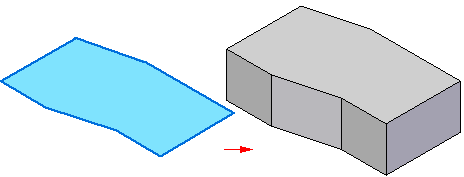
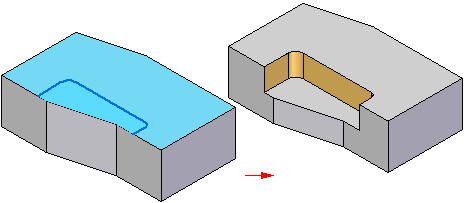
There are a variety of visual sketching aids available to you. The triad in the center of the graphics window is the base coordinate system.
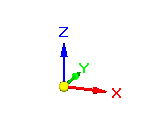
The principal planes on the base coordinate system are typically used to draw the first sketch for the base feature on a new part.
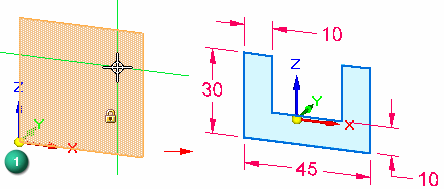
For more information, see Coordinate systems.
You can also independently display the sketching grid, alignment lines, and coordinate readouts using the Grid Options command.
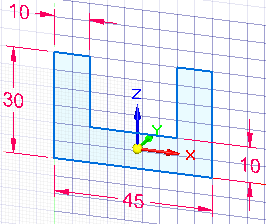
For more information, see Working with grids.
Getting started with sketching is easy. When you sketch elements, they will go on the coordinate system plane, planar face, or reference plane that is directly under your cursor when you start placing the element.
When starting a new part, you would typically draw a sketch on one of the three principal planes of the base coordinate system. For example, you can draw the first sketch for a new part on the XZ principal plane of the base coordinate system (1).

You can see which plane of the coordinate system you will draw on because the plane under the cursor highlights, and the alignment lines, which extend out from the cursor, adjust dynamically depending on what plane your cursor is over.
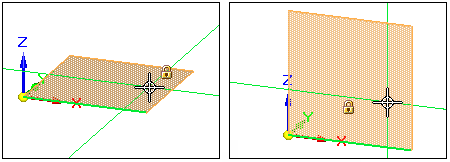
When you click to define the first endpoint of an element, such as a line, sketch input is locked to the current plane.
Note:
If there is not a coordinate system plane, model face, or reference plane under your cursor, the element will fall on one of the three principal planes of the document. The system will automatically choose the one that is flattest to the view.
See the Help topic, Start a sketch, to learn how to get started.
Many of the sketching commands require a locked sketch plane for placement of 2D geometry in 3D model space.
There are two methods for locking the sketch plane:
Automatic locking, where the active command locks the sketch plane for you, and unlocks the sketch plane when you start another command. This makes it easy to get started.
Manual locking, where you lock the sketch plane, and unlock it later yourself. This is useful for complex sketches or for sketches where the sketch geometry extends beyond the boundary of the sketch plane.
Note:
To learn more, see: Sketch plane locking.
A synchronous sketch drawn on a model face is automatically locked to the face. As the face moves, the sketch moves with the face. By default, the Live Rules option Maintain Sketch Planes is on.

To unlock the sketch from the model face, turn off the Maintain Sketch Planes option in Live Rules.
If a sketch is drawn on a model face that is coplanar to a base reference plane, the sketch is not locked to the model face.
When you highlight a coordinate system plane, planar face, or reference plane on which you want to draw a sketch, a default X-axis orientation is displayed automatically (1).
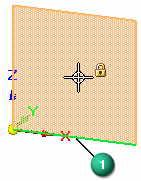
While you are defining the sketch plane and the default X-axis is highlighted (1), you can use the shortcut keys to change the X-axis orientation. For example, you can press the N key to select the next linear edge (2), or the B key to select the previous linear edge (3).
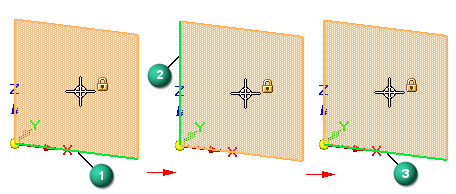
The valid shortcut keys for defining the X-axis orientation of a sketch plane are displayed in PromptBar when you are defining the sketch plane.
The X-axis orientation (1) (2) of a sketch controls the dimension text alignment for dimensions, and determines the horizontal and vertical axes for horizontal and vertical relationships.
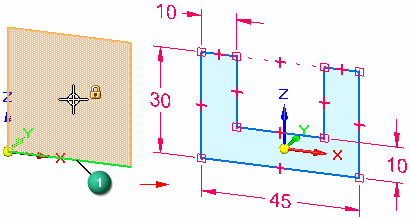
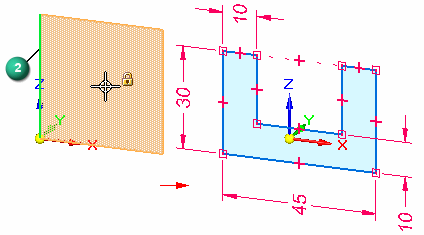
In a part or sheet metal document, when you draw 2D sketch elements that form a closed area, the closed area is automatically displayed as a sketch region (1). When working in a shaded view, the closed region also displays as shaded.
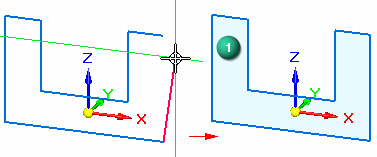
In a part or sheet metal document, you can use sketch regions to construct features using the Select tool. Sketch regions are formed automatically when a series of sketch elements close on themselves (1), or when sketch elements and one or more model edges form a closed area (2).
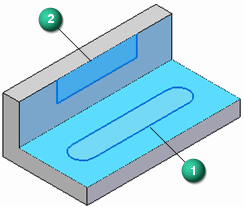
As you draw, you may want to disable sketch regions. You can do this by clearing the Enable Regions command, which is located on the shortcut menu when you select a sketch in PathFinder.
You can use the Enable Regions command to turn region selection on again.
The Enable Regions command is not available in an assembly document.
You can add dimensions and geometric relationships to control the size, shape, and position of the sketch elements. You can also place dimensions and geometric relationships relative to the primary axes of the coordinate system. This can be especially useful for symmetric parts during later design modifications. For example, the 10 mm and 22.5 mm dimensions were placed relative to the X and Z axes of the base coordinate system.
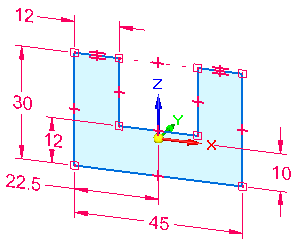
Note:
You can display and hide geometric relationships using the Relationship Handles command.
You can also define functional relationships using the Variables command.
To keep dimensions horizontal and vertical to the sketch geometry, you can move the sketch plane origin and reorient the sketch plane X-axis using the Reposition Origin command on the Sketching tab. This makes it possible to draw and dimension on different coplanar faces in the same sketch, yet keep dimension text and relationships oriented to an edge on the face, as shown.
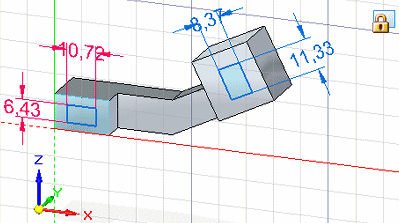
Note:
To learn how, see the Help topic, Set sketch plane horizontal and vertical orientation for dimensioning.
When you use a sketch to construct a feature in a part or sheet metal document, by default, the sketch elements are automatically consumed and transferred to the Used Sketches collection in PathFinder and the dimensions on the sketch are automatically migrated to the appropriate model edges when possible.
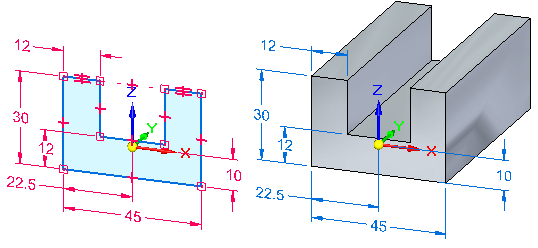
Note:
After you construct a feature in a synchronous model, the original sketch geometry does not drive the feature.
You can use the Migrate Geometry and Dimensions command on the shortcut menu when a sketch is selected in PathFinder to control whether sketch elements are consumed and dimensions are migrated when you construct features using the sketch.
To learn more, see Modifying synchronous models and Sketch consumption and dimension migration.
You can move and resize sketch elements using the Select tool. You also can edit sketch elements using commands such as Extend To Next, Trim, Mirror, Scale, Rotate, Stretch, and so forth. With these commands, you select the command first, then follow the prompts to edit the sketch elements you want.
See the Help topic, Edit a sketch.
The sketches you draw are listed in PathFinder. PathFinder also lists the base coordinate system, PMI dimensions, the base reference planes, features you construct, and used sketches.
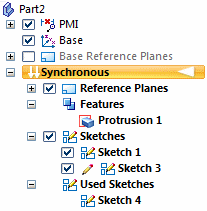
You can display or hide individual sketches or all the sketches in the document using the check box options in PathFinder and commands on the PathFinder shortcut menu.
When a sketch name is selected in PathFinder, you can use shortcut commands to:
For more information, see Using PathFinder in a part model.
Sometimes you may want to move or rotate an entire sketch to a new position in space. By default, when you use the Select tool to select sketch elements in the graphics window, only a sketch region or the selected sketch element is selectable.
To select an entire sketch, you can select the sketch entry in PathFinder, or you can use QuickPick to select the sketch in the graphics window.
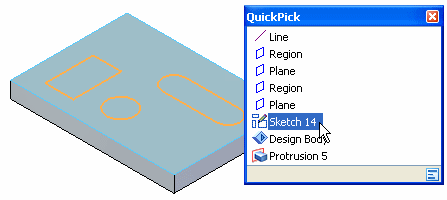
You can then use the steering wheel to move or rotate the sketch to a new position in space.
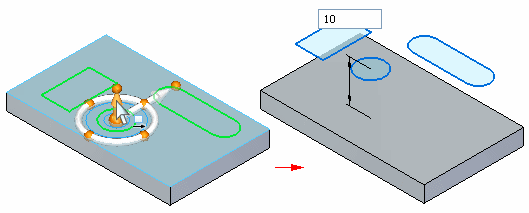
If the sketch in moved such that it becomes coplanar to another sketch, the two sketches are combined into one sketch, unless the Merge Coplanar sketches option has been cleared for one of the sketches.
For more information, see Working with combinable sketches.
Sketch geometry is not directly associative to the plane or face on which it is drawn. If you move the plane or face on which the sketch is drawn, the sketch geometry does not move unless it is also in the select set. This does not apply to sketches drawn on the principal planes of the base coordinate system or the base reference planes, as these planes are fixed in space.
You can apply 2D geometric relationships between sketch elements and model edges. If the model edges move, the sketch elements and geometric relationships update.
To restore a sketch to its original location on the model, use the Restore command on the shortcut menu when a used sketch is selected. This can be useful if you want to use the sketch to construct another feature elsewhere on the model or if you deleted the feature that the used sketch described.
See the Help topic, Restore a used sketch.
You can use the Project to Sketch command on the Sketching page to project model edges or sketch elements onto the current sketch plane. The sketch elements you project are associative to the parent element. If the parent element is modified, the projected element updates.
Note:
The associative link between the parent element and the projected element is discarded when you construct a feature using the projected elements.